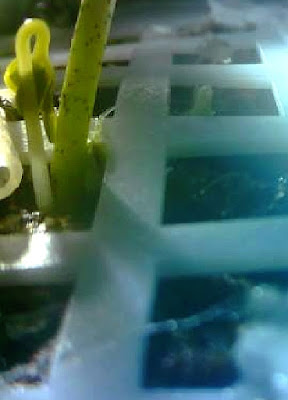 |
| A cotton plant sprout on the "dark side" of the moon. |
"Seeds Just Sprouted On The Moon For The First Time In History
In a development that will likely have huge implications for the future of space travel, China’s Chang’e 4 lunar lander successfully managed to plant and sprout cotton seeds on the Moon. This of course marks the first time that a plant has ever grown on the Moon, with the seeds naturally sprouting in a specially designed and concealed container. Incidentally, the Chang’e 4 lander first touched down on the far side of the Moon earlier this month, an impressive achievement in and of itself."
In making the announcement Tuesday, Chinese researchers released pictures from the probe showing the tiny plant growing in a small pot inside the spacecraft, hundreds of thousands of kilometers away from the Earth."
- Excerpt from a Yahoo article found today which has since disappeared (?), but for other news sources see: The Daily Mail's: One giant leaf for mankind!, the BBC's China's Moon mission sees first seeds sprout, Space.com's Cotton Seed Sprouts on the Moon's Far Side in Historic First by China's Chang'e 4, or CNN's China might just have grown the first plant ever on the moon.
 The lunar mission's name Chang'e is the name of their Moon Goddess (above), the immortal maiden who lives on the moon. The lunar rover, on the other hand, is named Yotu, the Jade Rabbit who lives on the moon as a companion to Chang'e, mixing her an elixir of mortality (inset right, sourced here) under an osmanthus tree; a symbol of good luck to humans on earth. As it stands, while we interpret the markings on the moon to represent a "Man," the Chinese see those same markings as a rabbit, the Rabbit on the Moon.
The lunar mission's name Chang'e is the name of their Moon Goddess (above), the immortal maiden who lives on the moon. The lunar rover, on the other hand, is named Yotu, the Jade Rabbit who lives on the moon as a companion to Chang'e, mixing her an elixir of mortality (inset right, sourced here) under an osmanthus tree; a symbol of good luck to humans on earth. As it stands, while we interpret the markings on the moon to represent a "Man," the Chinese see those same markings as a rabbit, the Rabbit on the Moon.
***
 |
| Chang'e, the Moon Goddess. |
Well, thus far, I haven't been able to say that 2019 has kicked off too encouragingly... that is, until I found the above article this morning which actually brought a smile to my grim and half-conscious face. But then, I sort of love everything about China's recent moon mission, because it ties in so enchantingly with Chinese mythology and folklore.
 The lunar mission's name Chang'e is the name of their Moon Goddess (above), the immortal maiden who lives on the moon. The lunar rover, on the other hand, is named Yotu, the Jade Rabbit who lives on the moon as a companion to Chang'e, mixing her an elixir of mortality (inset right, sourced here) under an osmanthus tree; a symbol of good luck to humans on earth. As it stands, while we interpret the markings on the moon to represent a "Man," the Chinese see those same markings as a rabbit, the Rabbit on the Moon.
The lunar mission's name Chang'e is the name of their Moon Goddess (above), the immortal maiden who lives on the moon. The lunar rover, on the other hand, is named Yotu, the Jade Rabbit who lives on the moon as a companion to Chang'e, mixing her an elixir of mortality (inset right, sourced here) under an osmanthus tree; a symbol of good luck to humans on earth. As it stands, while we interpret the markings on the moon to represent a "Man," the Chinese see those same markings as a rabbit, the Rabbit on the Moon.
I note, in an earlier article about the mission, Chinese scientists had intended to send some silkworm eggs. I don't know how I feel about that. In ways, plants and silkmoths alone on the moon seems eerily romantic. in other ways it seems cruel.
BTW, apparently, in 2013, NASA had plans for Moon plants (see here).
BTW, apparently, in 2013, NASA had plans for Moon plants (see here).
Come now...there is always encouraging news if we look beyond the borders of the United States of Madness. Huzzah for the Chinese and their success in landing on the far side of the moon.
ReplyDeleteMhm....and sending living organisms does seem a bit cruel - with no return.
Hah, yes, the United States of Madness for sure.
ReplyDeleteThat being said, the plant on the moon did cheer me up. As for the silkworm eggs... well, I guess what bothers me is the idea of flying creatures trapped in containers. But, then, I believe the silkworm moths have been bred over time to become flightless... if that's any consolation.
Well....you encouraged me to do a bit of research into the domesticated Bombyx mori. Most interesting.
Delete"Most of the domesticated pupae do not develop into moths as they are killed before they can break the precious cocoons. The cocoons are usually boiled, as this enables the 300-900 metres of silk to be unwound." (from https://silkroaddigressions.com/2017/09/26/feeble-silkworms-and-flightless-moths/)
So...I suppose a short life on the moon compared to a short life on earth would be at least a more interesting existence.
For whatever reason, I am suddenly unable to reply in "reply"-mode on this blog... but, in any case, you know, BG, I think you're absolutely right! :-)
ReplyDelete